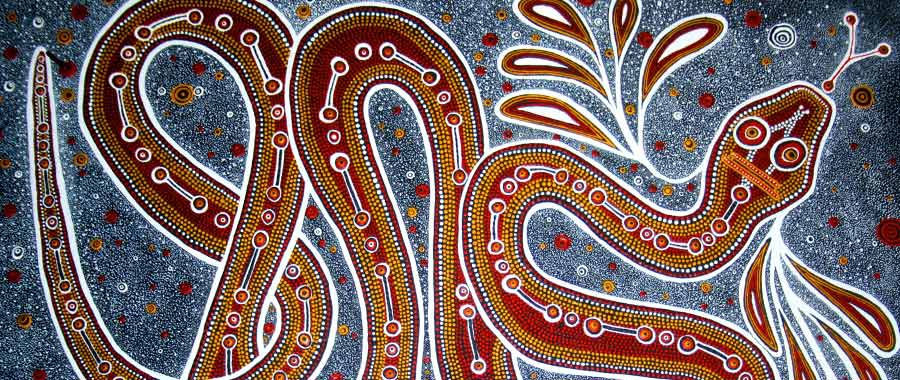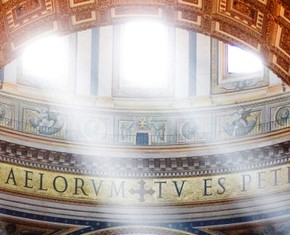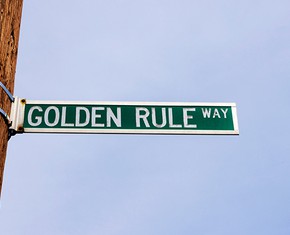The views expressed in our content reflect individual perspectives and do not represent the authoritative views of the Baha'i Faith.
If you live in Australia today, or visit that wonderful continent anytime soon, you’ll probably see a rainbow serpent—not a real serpent, but a universal symbol.
You’ll undoubtedly notice artwork, window stickers and even music festivals that depict the Rainbow Serpent—an Aboriginal representation of the Creator. How did that ancient symbol become so widespread there, and what does it mean?
One Aboriginal Baha’i named Philip (Guburu) Obah, an elder of the Wadja people of North Queensland, recently re-published a book entitled, The Baha’i Faith: An Australian Aboriginal Perspective (2002/2017). Previously, in a Gallup interview, Mr. Obah explained the “Rainbow Serpent”:
“Everything has a spirit to the aborigines who believe the air, rocks, trees, language, law and culture and art all come from the Creator.

Australian Aboriginal rock painting of “The Rainbow Serpent”.
“The aborigines believe that a rainbow serpent was God’s Messenger, teaching moral and spiritual laws. Obah said these laws also helped the aborigines adapt to harsh Australian environments. However, Christian missionaries in Australia saw it differently.
“In the Bible the serpent was evil because it tempted Adam and Eve,” Obah said. “They thought the aborigines were worshipping the devil.”
“God appeared to Moses as a burning bush,” Obah said. “If God could appear to Moses as a burning bush, surely he could appear to us as a rainbow serpent.”
Obah also addressed the aboriginal oral tradition, which is often seen as being inferior to a written tradition. He argues that just because it’s not written in the Bible doesn’t mean it never existed.”
RELATED: Aboriginal and Baha’i: Merging Traditional and New
So who, or what, is the “Rainbow Serpent?” Traditions associated with the Rainbow Spirit are said to be the longest continuous mythological tradition in the world. In 1987, Paul S. C. Taçon, Meredith Wilson and Christopher Chippindale, three archaeologist/anthropologists, summed up the importance of the Rainbow Serpent this way in “Birth of the Rainbow Serpent in Arnhem Land Rock Art and Oral History”: “Today, the Rainbow Serpent enjoys renewed popularity as a uniting symbol for Aboriginal people… It is also popular for non-Aboriginal people as a dramatic subject in bark or paper paintings or as a powerful symbol for those following New Age philosophies.”
A complex welter of myths and stories are associated with the Rainbow Serpent, which vary greatly, depending on tradition and locality. They represent a message of unity and peace to Aboriginals and, in a wider sense, in Australian popular culture today. The Rainbow Serpent has taken on a powerful symbolism that represents not only an ancient belief but a present-day worldview—that like the multiple colors of the rainbow, we are united. The Baha’i teachings explain the symbol of a rainbow in a very similar way in “Star of the West”:
“Regarding the rainbow, this rainbow is the Covenant of God and the Testament of the Merciful One. The lights of the Kingdom and the heavenly illumination emanated from this rainbow. This rainbow is the sign of the removal of the wrath of God from all the people and the sign of prosperity, tranquility, universal peace, the oneness of humanity, and the unity of the world of man.”
With the spiritual symbol of the Rainbow Serpent, the Aboriginal God of creation has, in a sense, been re-created. After surveying and analyzing 107 rock paintings depicting the Rainbow Serpent in a wide variety of images, Taçon, Wilson and Chippindale concluded as follows, regarding the unifying power and significance of the Rainbow Serpent among Aboriginals today:
“The Rainbow Serpent has been used to define the nature of human existence for at least 4000–6000 years; it has become a symbol of the creative and destructive power of nature. … Both Lewis (1988) and Taylor (1990) have shown how the Rainbow Serpent image acts to bring together and unite neighbouring or more diverse groups of Aboriginal people by emphasising their common origins, shared heritage, and there being an aspect of rainbowness in all of us. Restricted ceremonies like Kunabibi reaffirm this. So do the [Aboriginal] creation stories themselves. In this sense, the Rainbow Serpent can be considered a symbol of integration and, ultimately, peace. … Perhaps the Rainbow Serpent emerged not only to define and describe the nature of a changing universe, along with the position of humans within it, but also to bring people together, to unite them behind a shared symbol, experience and common cause. The fact that rock art depictions of Rainbow Serpents are found at hundreds of prominent, accessible locations near or at camp sites throughout Arnhem Land [the five regions of the Northern Territory of Australia] reinforces this interpretation. Its presence there would have acted as a constant reminder of similarity between humans, rather than difference, as well as of intimate relationship to particular landscapes and other creatures.”
RELATED: The Spiritual Destiny of Indigenous Peoples
The Rainbow Serpent represents an Aboriginal perspective on the divine spirit and creative power manifest in all creation. So pervasive is the Rainbow Serpent in Aboriginal tradition, that respecting and honoring what their tradition represents is an important bridge between all things Aboriginal and the Baha’i Faith. As Banjo Clarke explained in his book “Wisdom Man”:
“I think that if Aboriginals studied the Baha’i Faith they’d come back to their real selves again, because the Baha’i Faith is so like the Aboriginal way of life. The Baha’i writings say that in the future humankind will be so sensitive that no one anywhere in the world will be able to sit down to a meal if they know that somewhere in the world a person is starving. Aboriginal feelings are like those writings. We feel united with everyone. Sometimes we get terrible feelings because we know something terribly bad is happening. And we start to cry as if somebody was telling us—but nobody is telling us. We can feel it. Aboriginals can’t explain them things, and it’s frightening too. You don’t know if it’s going to be yourself or somebody close to you, so you wait patiently for the message. The warning makes you able to bear it.
“It’s still like that. White people have got these things, but a lot of them don’t care for these things any more. But these feelings inside of them will govern them in the future. Like in the Baha’i writings.”
Rather than being an Indigenous Messenger of God, the Rainbow Serpent may instead represent a Indigenous message from God. A rainbow, by its very nature, is a spectrum of colors, displayed in splendid array across the sky after a cleansing and refreshing rain shower.
In this way, the Rainbow Serpent represents not only Aboriginals, but also peoples of all hues, tints and tones of skin—and what lies within their hearts and souls—throughout the world today. The Baha’i Faith, in that sense, can be said to be harmonious with the spirit and power of the Aboriginal—and original—Rainbow Serpent.
You May Also Like
Comments

















8The Lord said to Moses, “Make a snake and put it up on a pole; anyone who is bitten can look at it and live.” 9So Moses made a bronze snake and put it up on a pole. Then when anyone was bitten by a snake and looked at the bronze snake, they lived.